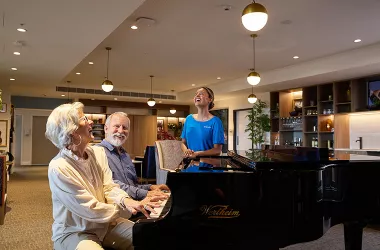Designing buildings for residential aged care
14th April 2023 | 6 minsHow does the way we design our buildings improve the lived experience in residential aged care?

This was the subject of an Opal HealthCare Panel Discussion with experts in architecture, design, dementia care and the resident experience, and attended by people across the aged care sector.
Lesley Palmer, Chief Architect Dementia Services at Stirling University in Scotland was joined on the panel by Maree McCabe, CEO Dementia Australia; resident spokesperson Margaret, whose husband resides in an Opal HealthCare Care Community; and Brad Sebastiao, Head of Design Innovation at Opal HealthCare. Our Panel Chair was Elliot Stein, Director of Government, Regulatory and External Affairs at UNICEF Australia and a member of the Opal HealthCare Advisory Group.
Here are four key takeaways from the discussion:
1. The built environment is an important determinant of our health and wellbeing and is crucial to support dignity and identity.
For those living with dementia the design of their residence is crucial in supporting dignity and identity. Lesley Palmer explained that dementia design principles enable not only the person living with dementia, but also their loved ones and the care teams proving daily assistance.
“Dementia design principles involve seeing the person for who they are, and not the dementia,” said Lesley.
"It takes into account perceptual differences, lighting, shadows, tones, textures, sensory stimulation and even air quality. People with cognitive decline are constantly looking for social cues on what do to, and if the environment doesn’t enable those cues, their confidence drops. It’s wonderful to see Opal HealthCare embrace these principles and to hear about the positive impact these principles have made from both care teams and residents' family members.”
2. Basic dementia design principles make a difference for everyone
“Environments either enable and promote independence or create barriers and thwart independence,” said Maree McCabe.
Small changes in the environment can make a big difference to the lives of people living with dementia and support them remaining at home for longer. Dementia friendly environments make a difference to others as well and support healthy ageing, including those who are not experiencing cognitive decline. Fundamentally they represent good design principles.
3. Incorporating a variety of different living and activity spaces enhances the resident experience
Margaret’s husband has dementia and lives at Glenmore Park Glenmore Park Community where she spends time with him every day. It’s important to Margaret that high quality care is augmented by a living environment that supports her husband’s wellbeing and enjoyment.
“Moving within Glenmore Park Care Community to very different activity areas during the day is a ‘trip out’ for my husband. The thoughtfully designed and very distinct spaces within the Care Community really encourage visitors of all ages to come and spend time with my husband. The design flow from indoors to the outside areas enables me to easily encourage my husband ‘out’ each day. Even though he may not remember it afterwards, I know that in the moment he is happy and that’s why it’s so important.
4. Consultation with residents and families is an essential element of the design process
For new buildings, Opal HealthCare uses a ‘small household’ model based on 15-18 residents living in each neighbourhood. The aim is to create small communities of people within a larger community to support meaningful resident outcomes such as belonging, connection with others, feeling safe and promoting independence.
“Legible design and wayfinding promote horizontal and vertical movement so that the amenities, destinations and engagement spaces enhance quality of life,” said Brad.
“Conducting research, consultation and community engagement as part of the design process for both existing and new Care Communities is a key part of this. It’s necessary to consider diverse perspectives to ensure our built environments add value to the lives of our residents and their families.”
For more information about dementia care and design for better living at Opal HealthCare, contact us.
Stories from across our Care Communities

News & Events
Groundbreaking aged care in Canberra
25th November 2025 | 5 min read

Care Community stories
Welcome to Epping Grand Care Community
5th November 2025 | 3 min read

Care Community stories
Faith, love and connection at Ashmore Gardens
3rd November 2025 | 3 min read


